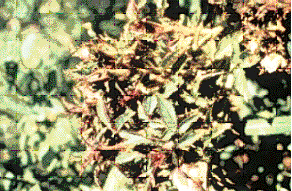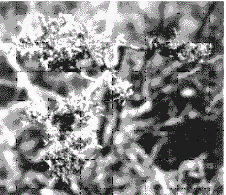Reports on Plant Diseases |
RPD No. 666 - Rose Rosette Disease
|
October 1999
|
[ Symptoms ] [ Disease Cycle
] [ Control ]
|
The causal agent of rose rosette disease (RRD), also known as witches'
broom of roses (Rosa species), is unknown, although double-stranded
RNAs have been associated with diseased plants. RRD is a fatal disease
of multiflora rose (R. Multiflora), designated a noxious weed in
several states. It occasionally infects numerous species, hybrids and
cultivars of ornamental and garden roses, grown outdoors and in greenhouses,
including climbers, hybrid teas, floribundas, miniatures, and a number
of antique or "old fashioned" roses. Roses are the only plant
known to be susceptible to RRD. The majority of multiflora roses in the
Midwest and eastern United States are expected to become infected and
killed by RRD in the next 10 to 20 years. The disease was first reported
in 1941 in Manitoba, Canada, Wyoming, northeastern California, and Nebraska.
RRD is now endemic in much of the Midwest, where multiflora rose hedges
are common; was first reported in Illinois in 1986; and is spreading naturally
in the eastern United States.
|

Figure
1. Bunchy cluster (witches' broom); dwarfed and distorted leaves
on garden rose
|
RRD is transmitted from plant to plant by an extremely small eriophyid
mite (Phyllocoptes fructiplilus), which inhabits the shoot
tips and leaf petal bases of roses. This mite introduces the causal
agent of RRD into a rose as it feeds. The 4-legged mite is only
about 200 microns long and 50 microns wide – small enough so
20 could lie side-by-side on a pinhead. The causal agent is also
transmitted through grafting but apparently not through multiflora
rose seed. Graft transmission tests have shown that the causal agent
resides in the roots of multiflora rose, as well as other plant
parts.
|
|
Symptoms
On multiflora rose the first symptoms appear 17 to 90 days or more after the
mites have inoculated the plant. The majority of new infections appear in July
and August. A brighter red to dark red mosaic pattern forms on the new leaves.
The pattern follows the leaf veins or may appear as spots and blotches. The
easily seen mosaic pattern is diagnostic of RRD infection. Thirty to 90 days
after the mites have transmitted the causal agent, an infected plant begins
to produce numerous lateral shoots that grow in different directions. These
shoots are commonly bright red and often are much larger in diameter than the
canes from which they grew. A proliferation of these shoots produces a witches'
broom symptom.
The red shoots of infected plants are succulent, and more susceptible to late
frost damage than the normal healthy foliage of multiflora rose. A variety of
other symptoms can be seen in late May and early June including rapid stem elongation
followed by breaking of axillary buds which results in numerous red lateral
shoots and thick, bunchy clusters of wrinkled, reddish green leaves which are
distorted and much reduced in size (Figure 1). The leaf clusters often serve
as winter protection for the mite vector. Infected canes have an abnormally
high number of thorns.
|

Figure
2. Multiflora rose hedge killed by RRD. Note elongated lateral stems
growing in different directions.
|
The causal agent of rose rosette spreads from infected canes into the
roots and from there to all the canes on a plant. Some canes produce only
sparse red and yellow foliage; others die and turn brown. Under drought
conditions, some diseased tips produce firmer foliage and yellowish leaf
tips in addition to being a bright pink. About 10 to 15 percent of infected
plants show a "regression" or loss of symptoms for one or more
months but the symptoms always reappear. The entire multiflora rose plant,
including the root system, dies an average of 22 months after becoming
infected (Figure 2).
On garden roses, the symptoms are usually less severe than on multiflora
rose, but some cultivars are killed by the disease. In some ornamental
roses the symptoms appear to be transient and the plants "recover";
while other plants, weakened by RRD, die with another disease.
Rapid stem elongation is an early symptom of RRD in garden roses (Figure
3). Later, certain canes become greatly thickened, almost "furry"
with thorns, and are slow to mature. Such shoots usually die back in late
fall. Many short, deformed shoots will form, often with red blotches and
streaks, an increased number of buds, and tiny misshapen leaves (Figure
4). Flower parts are distorted, abortive, leaflike, and sterile on infected
stems although other parts of the plant may appear completely healthy
and produce normal flowers and fruit. Infected plants commonly die within
one to two years as symptoms eventually affect all canes.
|

Figure
3. Rose Rosette Disease - infected garden rose - stems growing in
different directions.
|
Back to Top
Disease Cycle
| At present there is no practical control for this disease.
Rose plants showing symptoms of RRD should be promptly dug up and destroyed
when the disease is first noticed. It is strongly suggested that multiflora
and garden roses be separated as far as possible from each other. Multiflora
rose hedges should be destroyed whenever possible. (Garden roses infected
with other viral diseases would not necessarily have to be removed). Control
of the mites that transmit RRD is probably not practical. Short-term mite
control to protect healthy plants, while infected plants are being destroyed,
can be accomplished with weekly spraying of dicofol (Kelthane), dienochlor
(Pentact), or fenbutatin-oxide (Vendex). There is some evidence to suggest
that mites transmit the disease between plants during May and June, making
this time period the most important for mite control. However, as suggested
above, destroying diseased plants is a more practical solution to control
of RRD. |

Figure 4. Short,
deformed shoots, increased number of buds, numerous tiny, misshapen leaves
- other symptoms of rose rosette on garden roses.
|
Back to Top
Control
Although the mites can be found on a number of rose species over much of the
United States, large populations develop on multiflora rose infected with RRD.
Some mites climb to the edges of young leaves, become airborne, and may drift
for several miles like dust particles. Mites from diseased plants may initiate
a new infection when they land and feed on succulent, rapidly growing tissue
of another multiflora or garden rose. Spread of the causal agent of RRD within
garden roses is generally minor, it has caused considerable losses in a few
urban areas (including Kansas City, Topeka, St. Joseph and Springfield, Missouri)
several miles or more from the nearest multiflora rose hedge. The complete disease
cycle is unknown at present. For example, why is the disease so devastating
to multiflora rose with generally minimal spread within garden roses? Research
is needed to characterize the causal agent, to develop a DNA probe for detection
of the causal agent, to define the conditions favoring development and spread
of the disease, to study aspects of mite biology, including how transmission
occurs, and what factors determine mite populations. Apparently the mites lose
much of their capacity to transmit the causal agent of RRD after 10 days. Transmission
by mites is often erratic and adversely affected by drought or plant stress
or both.
Back to Top
For further information concerning diseases of woody ornamentals, contact
Nancy R. Pataky, Extension Specialist and Director of the Plant Disease Clinic,
Department of Crop Sciences, University of Illinois at Urbana.
University of Illinois Extension provides equal
opportunities in programs and employment.
|



